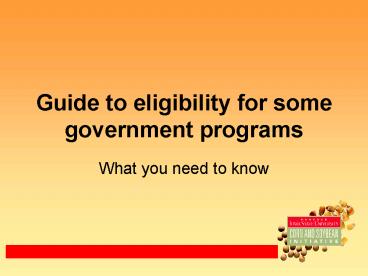Guide to eligibility for some government programs - PowerPoint PPT Presentation
1 / 19
Title:
Guide to eligibility for some government programs
Description:
Weeds present and pressure. Insects (BCW, flea beetle, etc.) Estimate residue cover ... Evaluate weed control. What insects are present, and consider economic ... – PowerPoint PPT presentation
Number of Views:39
Avg rating:3.0/5.0
Title: Guide to eligibility for some government programs
1
Guide to eligibility for some government programs
- What you need to know
2
- This program is produced in cooperation with the
Iowa Department of Agriculture and Land
Stewardship, with funds provided by EPA Region 7
3
What is a conservation plan?
- A prepared strategy to protect the environment
from possible adverse effects of farm activities - Feasible for the producer
- (workload and financially)
- Allows supported (funded) activities
- Might be amendable
4
What you need
- Records start planning now!
- On-farm activities plan (including scouting)
- Lay out a protocol for IPM
- Use the protocol to plan for records to keep
- Should be useable for the one making decisions
5
Crop Nutrients
- Time of application
- Rates of nutrient materials
- Soil sampling
- P index
- N
- Manuring
- New in Iowa restrictions on
- ground going to soybean
6
What is scouting?
- Make scouting pay for you
- First understand the crop and pests
- Second determine action thresholds
- Scouting is a planned gathering of information
that fuels decision-making.
7
Step 1 get accurate soil maps for the farm
- soil survey
- Hand-made maps
- Downloaded from online databases
- FSA base maps
- others
8
Step 2 Identify special areas (i.e., possible
setbacks)
- Label-specific (atrazine, acetochlor, etc.)
- streams, tile intakes, well sites, mix sites
- Wells, active, standby, or abandoned
- Sinkholes, lakes, streams
- Other
- Public use areas (schools, trails, adjacent
homes) - Use common sense
9
Step 3 Timely scouting
- Addresses crop pests, focused on five times
during the season - 2-3 weeks post crop emergence
- 3-7 weeks post emergence
- 3-10 days after each pesticide application
- at reproductive stage of the crop (tassel or pod
set - just prior to harvest
10
2-3 weeks post emergence
- CORN and SOYBEAN
- Stand count/uniformity
- Weeds present and pressure
- Insects (BCW, flea beetle, etc.)
- Estimate residue cover
11
3-7 weeks after planting
- Evaluate weed control
- What insects are present, and consider economic
thresholds
12
Following pesticide applications
- (within 3-10 days of each)
- Note and follow appropriate re-entry times
- Document effectiveness of treatment
- Do this for each application!
13
Reproductive stage
- CORN tasseling, BEANS full-flower
- Evaluate pests
- Insects
- Weeds
- Diseases
14
Reproductive stage
- CORN tasseling, BEANS full-flower
- 2. Document crop growth and health
- Iron chlorosis
- Hail/drought/flood damage
- Herbicide damage
- Etc.
15
August
- Tissue test to evaluate N use
- stalk tissue tests
- Review and evaluate pest management decisions
16
Throughout the season
- Follow label instructions
- possess any supplementary labels
- You need 3 years of records for some program
eligibility - The key is to document what you do
17
Questions
- Your county NRCS-District Conservationist
- ISU Extension nutrient guidelines and pesticide
resources - NOTE WIN-PST is a program to estimate pesticide
hazards talk with NRCS staff to use it before
you get frustrated!
18
- Forensic record keeping might be possible but
needs to represent reality.
19
- Surface crop residue at planting























![READ [PDF] The Complete Success Guide To Airbnb Rental Arbitrage: Build a Profitable Real PowerPoint PPT Presentation](https://s3.amazonaws.com/images.powershow.com/10086594.th0.jpg?_=20240726084)


![❤️[READ]✔️ Government Contracts in Plain English: What You Need to Know About the FAR (Federal A PowerPoint PPT Presentation](https://s3.amazonaws.com/images.powershow.com/10104450.th0.jpg?_=20240822073)
![[READ DOWNLOAD] Government Contracts in Plain English: What You Need to Know About the FAR (Federal Acquisition Regulation), DFARS, Subcontracts, Small Busi PowerPoint PPT Presentation](https://s3.amazonaws.com/images.powershow.com/10104893.th0.jpg?_=20240823128)



